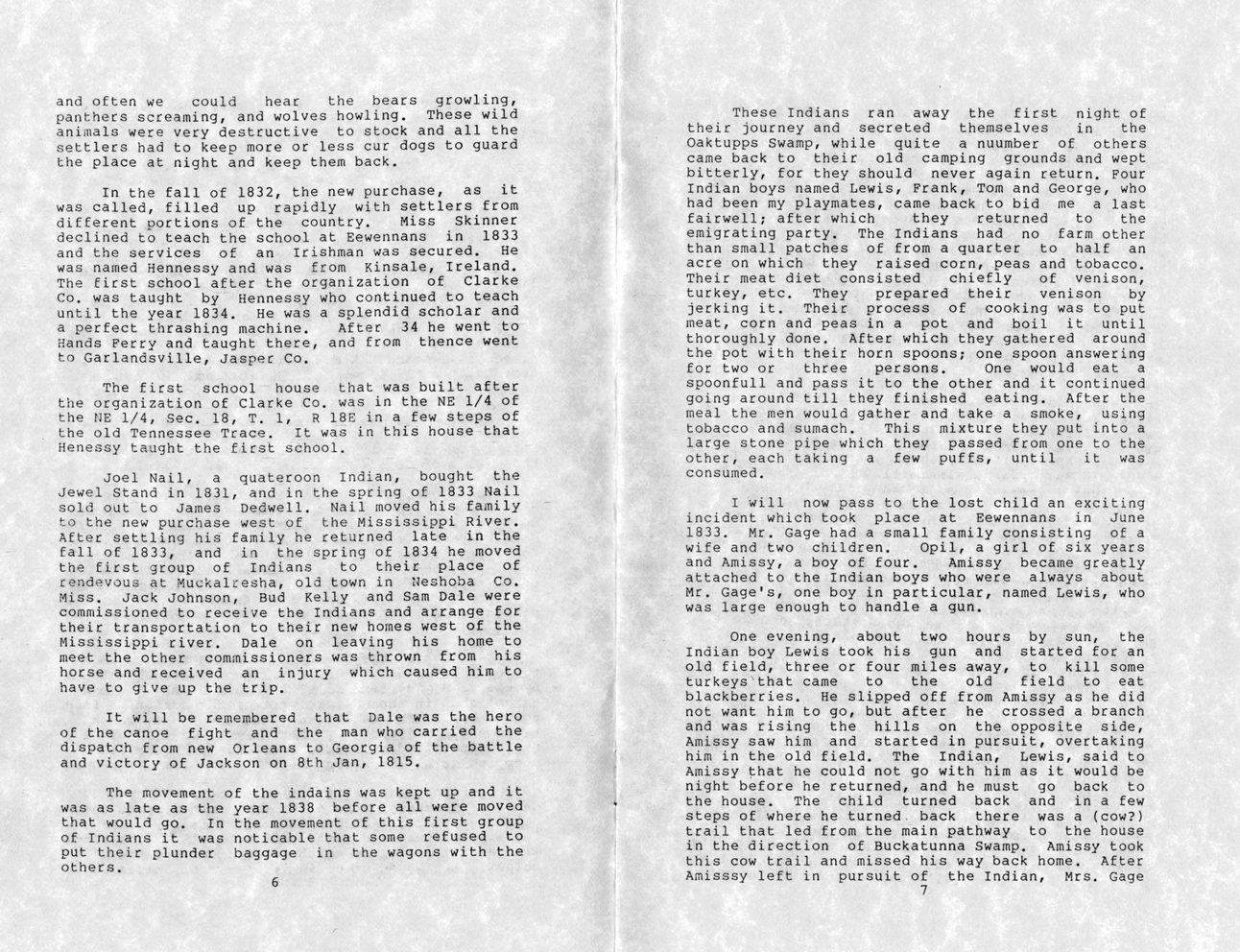This text was obtained via automated optical character recognition.
It has not been edited and may therefore contain several errors.
and often we could hear the bears growling, panthers screaming, and wolves howling. These wild animals were very destructive to stock and all the settlers had to keep more or less cur dogs to guard the place at night and keep them back. In the fall of 1832, the new purchase, as it was called, filled up rapidly with settlers from different portions of the country. Miss Skinner declined to teach the school at Eewennans in 1833 and the services of an Irishman was secured. He was named Hennessy and was from Kinsale, Ireland. The first school after the organization of Clarke Co. was taught by Hennessy who continued to teach until the year 1834. He was a splendid scholar and a perfect thrashing machine. After 34 he went to Hands Ferry and taught there, and from thence went to Garlandsville, Jasper Co. The first school house that was built after the organization of Clarke Co. was in the NE 1/4 of the tJE 1/4, Sec. 18, T. 1, R 18E in a few steps of the old Tennessee Trace. It was in this house that Henessy taught the first school. Joel Nail, a quateroon Indian, bought the Jewel Stand in 1831, and in the spring of 1833 Nail sold out to James Dedwell. Nail moved his family to the new purchase west of the Mississippi River. After settling his family he returned late in the fall of 1833, and in the spring of 1834 he moved the first group of Indians to their place of rendezvous at Muckalresha, old town in Neshoba Co. Miss. Jack Johnson, Bud Kelly and Sam Dale were commissioned to receive the Indians and arrange for their transportation to their new homes west of the Mississippi river. Dale on leaving his home to meet the other commissioners was thrown from his horse and received an injury which caused him to have to give up the trip. It will be remembered that Dale was the hero of the canoe fight and the man who carried the dispatch from new Orleans to Georgia of the battle and victory of Jackson on 8th Jan, 1815. The movement of the indains was kept up and it was as late as the year 1838 before all were moved that would go. In the movement of this first group of Indians it was noticable that some refused to put their plunder baggage in the wagons with the others. 6 These Indians ran away the first night of their journey and secreted themselves in the Oaktupps Swamp, while quite a nuumber of others came back to their old camping grounds and wept bitterly, for they should never again return. Four Indian boys named Lewis, Frank, Tom and George, who had been my playmates, came back to bid me a last fairwell; after which they returned to the emigrating party. The Indians had no farm other than small patches of from a quarter to half an acre on which they raised corn, peas and tobacco. Their meat diet consisted chiefly of venison, turkey, etc. They prepared their venison by jerking it. Their process of cooking was to put meat, corn and peas in a pot and boil it until thoroughly done. After which they gathered around the pot with their horn spoons; one spoon answering for two or three persons. One would eat a spoonfull and pass it to the other and it continued going around till they finished eating. After the meal the men would gather and take a smoke, using tobacco and sumach. This mixture they put into a large stone pipe which they passed from one to the other, each taking a few puffs, until it was consumed. I will now pass to the lost child an exciting incident which took place at Eewennans in June 1833. Mr. Gage had a small family consisting of a wife and two children. Opil, a girl of six years and Amissy, a boy of four. Amissy became greatly attached to the Indian boys who were always about Mr. Gage?s, one boy in particular, named Lewis, who was large enough to handle a gun. One evening, about two hours by sun, the Indian boy Lewis took his gun and started for an old field, three or four miles away, to kill some turkeys that came to the old field to eat blackberries. He slipped off from Amissy as he did not want him to go, but after he crossed a branch and was rising the hills on the opposite side, Amissy saw him and started in pursuit, overtaking him in the old field. The Indian, Lewis, said to Amissy that he could not go with him as it would be night before he returned, and he must go back to the house. The child turned back and in a few steps of where he turned, back there was a (cow?) trail that led from the main pathway to the house in the direction of Buckatunna Swamp. Amissy took this cow trail and missed his way back home. After Amisssy left in pursuit of the Indian, Mrs. Gage

Evans 002